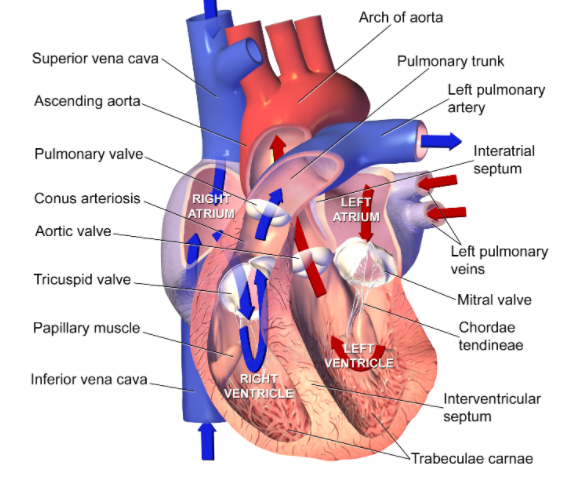
Write two functions of the two upper chambers of Human Heart.
Answer
439.8k+ views
Hint: The heart is a vital organ present in the human body. It pumps blood to various organs. The heart consists of four chambers and the associated blood vessels. It constitutes the circulatory system of the body.
Complete answer:
The human heart consists of four chambers. The upper two chambers are known as the Atria or the Auricles, while the lower two chambers are known as the Ventricles. The blood flowing into the heart is through the vena cava, which is the largest vein in the human body. It brings blood to the right upper chamber known as the right atrium. Which in turn passes onto the lower chamber known as the ventricle.
The atria make sure that the ventricles are filled adequately with the blood. The chambers also regulate functions such as cardiac output. The right atrial also consists of a node known as the sino-atrial node or the SA node, which functions as the natural pacemaker of the heart. Thus, the major functions of the atria or the upper heart chambers are inefficiently filling the lower chambers or the ventricles and also in controlling various cardiac functions such as the cardiac output.
 Anatomy of Human Heart
Anatomy of Human Heart
Additional information:
There are valves present in the hearts, which prevents the back-flow of blood. There are mainly two types of valves known as the tricuspid and the bi-cuspid valve which consists of three and two flaps respectively.
Note: The circulatory process by the human heart is by a process known as the double circulation. By this process, the blood which gets circulated flows twice through each chamber, and also there are two pathways of flow for oxygenated and deoxygenated blood.
Complete answer:
The human heart consists of four chambers. The upper two chambers are known as the Atria or the Auricles, while the lower two chambers are known as the Ventricles. The blood flowing into the heart is through the vena cava, which is the largest vein in the human body. It brings blood to the right upper chamber known as the right atrium. Which in turn passes onto the lower chamber known as the ventricle.
The atria make sure that the ventricles are filled adequately with the blood. The chambers also regulate functions such as cardiac output. The right atrial also consists of a node known as the sino-atrial node or the SA node, which functions as the natural pacemaker of the heart. Thus, the major functions of the atria or the upper heart chambers are inefficiently filling the lower chambers or the ventricles and also in controlling various cardiac functions such as the cardiac output.

Additional information:
There are valves present in the hearts, which prevents the back-flow of blood. There are mainly two types of valves known as the tricuspid and the bi-cuspid valve which consists of three and two flaps respectively.
Note: The circulatory process by the human heart is by a process known as the double circulation. By this process, the blood which gets circulated flows twice through each chamber, and also there are two pathways of flow for oxygenated and deoxygenated blood.
Recently Updated Pages
Can anyone list 10 advantages and disadvantages of friction

What are the Components of Financial System?

How do you arrange NH4 + BF3 H2O C2H2 in increasing class 11 chemistry CBSE

Is H mCT and q mCT the same thing If so which is more class 11 chemistry CBSE

What are the possible quantum number for the last outermost class 11 chemistry CBSE

Is C2 paramagnetic or diamagnetic class 11 chemistry CBSE

Trending doubts
The correct order of melting point of 14th group elements class 11 chemistry CBSE

One Metric ton is equal to kg A 10000 B 1000 C 100 class 11 physics CBSE

What is the specific heat capacity of ice water and class 11 physics CBSE

Define least count of vernier callipers How do you class 11 physics CBSE

What is the chemical name of Iron class 11 chemistry CBSE

The dimensional formula of dielectric strength A M1L1T2Q class 11 physics CBSE




